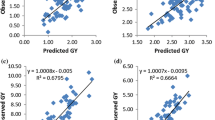Summary
Zein chromatographic and isozyme electrophoretic data were used to characterize 61 hybrids of maize (Zea mays L.) that are of current widespread usage in France. A similar study was also carried out for 88 hybrids that are widely available in the central corn belt of the U.S. Objectives were to 1) investigate the degree to which isozyme and chromatographic data could provide unique hybrid identification; 2) to evaluate the wealth of genetic diversity available among hybrids that are currently cultivated in France and in the U.S.; and 3) to compare the patterns and extent of genetic diversity found in both countries with respect to their registration, breeding, and seed production practices.
Isozyme data showed that all French hybrids were unique germplasm. However, numerous hybrids had chromatographic profiles that were identical for 11 major peaks and these hybrids could thus have some common germplasm at least among their female parental lines. Although there was a broad base of isozymic diversity among French hybrids, the amount in cultivation was less since the few most widely used hybrids, which were planted on approximately half the cultivated area, were similar for their isozymic and zein chromatographic profiles. Approximately only 50% of the U.S. hybrids were shown to be unique with the remainder classified into groups; at least some of the hybrids within each group could be genetically identical products. Leading U.S. hybrids were unique germplasm but numerous hybrids that collectively covered a large acreage appeared to encompass a relatively narrow genetic base.
For the continued success of agriculture, it will be important to improve breeding, registration, and marketing practices in order to ensure the continued supply of genetically different and improved elite hybrids.
Similar content being viewed by others
References
Bietz J.A., 1986. High-performance liquid chromatography cereal proteins. Adv. Cereal Sci. and Technol. 8: 105–170.
Cardy B.J., C.W. Stuber & M.M. Goodman, 1980. Techniques for starch gel electrophoresis of enzymes from maize (Zea mays L.). Institute of Statistics Mimeo Series No. 1317. North Carolina State University, Raleigh, NC.
Cooke R.J., 1984. The characterization and identification of crop cultivars by electrophoresis. Electrophoresis. 5: 59–72.
Frei O.M., C.W. Stuber & M.M. Goodman, 1986a. Use of allozymes as genetic markers for predicting performance in maize single cross hybrids. Crop Sci. 26: 37–42.
Frei O.M., C.W. Stuber & M.M. Goodman, 1986b. Yield manipulation from selection on allozyme genotypes in a composite of elite corn lines. Crop Sci. 26: 917–921.
Goodman M.M. & C.W. Stuber, 1983. Races of maize. IV. Isozyme variation among races of maize in Bolivia. Maydica. 28: 169–187.
Gower J.C., 1972. Measures of taxonomic distance and their analysis. In: J.S. Weiner & J. Huizina (Eds), The assessment of population affinities in man. Oxford Univ. Press, London. p. 371–380.
Ministère de l'Agriculture, 1986. Report Service Central des 084 Enquetes et Etudes Statistiques. Ministère de l'Agriculture. 4 Avenue St. Mande, Paris.
Price S.C., A.L. Kahler, A.R. Hallauer, P. Charmley & D.A. Giegel, 1986. Relationships between performance and multilocus heterozygosity at enzyme loci in single-cross hybrids of maize. Jour. Hered. 77: 341–344.
SAS 1985. SAS® User's Guide: Statistics, Version 5. SAS Institute Inc. Box 8000, Cary, NC, 956 pp.
Seedsman's Handbook, 1981. Mike Brayton Seeds, Inc., Ames, IA, 63 pp.
Smith J.S.C., 1984. Genetic variability within U.S. hybrid maize: Multivariate analysis of allozyme data. Crop Sci. 24: 1041–1046.
Smith J.S.C., 1986. Biochemical fingerprints of cultivars using reversed-phase high-performance liquid chromatography: a review. Seed Sci. and Technol. 14: 753–768.
Smith J.S.C., 1988. The diversity of U.S. hybrid maize germplasm; isozymic and chromatographic evidence. Crop Sci. 28: 63–70.
Smith J.S.C., S. Paszkiewicz, O.S. Smith & J. Schaffer, 1987. Electrophoretic, chromatographic, and genetic techniques for identifying associations and measuring genetic diversity among corn hybrids. Proc. 42nd Annu. Corn and Sorghum Ind. Res. Conf. Chicago, IL., Dec. 1987. American Seed Trade Association, Washington, DC.
Smith J.S.C. & O.S. Smith, 1987a. Associations among inbred lines of maize using electrophoretic, chromatographic, and pedigree data. Theor. Appl. Genet. 73: 654–664.
Smith J.S.C., M.M. Goodman & C.W. Stuber, 1985a. Genetic variability within U.S. maize germplasm. I. Historically important lines. Crop Sci. 25: 550–555.
Smith J.S.C., M.M. Goodman & C.W. Stuber, 1985b. Genetic variability within U.S. maize germplasm. II. Widely-use inbred lines 1970 to 1979. Crop Sci. 25: 681–685.
Smith O.S. & J.S.C. Smith, 1987b. Prediction of heterosis using pedigree relationship, biochemical, and morphological data. 23rd Annu. Illinois Corn Breeders' School. University of Illinois, Champaign, Urbana, IL.
Smith J.S.C. & H.H. Weissinger, 1984. Rapid monitoring of purity in seed lots of hybrid maize: Modifications of existing technologies. Maize Genet. Coop. News Letter. 58: 103–105.
Soave C. & F. Salamini, 1983. Genetic organization and regulation of maize storage proteins. In: J. Daussant, J. Mosse & J. Vaughan (Eds), Seed Proteins. Academic Press. London. p. 205–218.
Stuber C.W., J.F. Wendel, J.S.C. Smith & M.M. Goodman, 1987. Methodologies for the acquisition, scoring, and interpretation of isozymic data from maize (Zea maize L.). NCSU Mimeo (in press) North Carolina University, Raleigh, NC.
Tanksley S.D. & T.J. Orton, 1983. Isozymes in plant genetics and breeding. Parts A and B. Elsevier, Amsterdam.
United States District Court, 1987. Pioneer Hi-Bred International, Inc., an Iowa Corporation, Plaintiff versus Holden Foundation Seed Inc., et al., Defendants. U.S. District Court, Southern District of Iowa. Case No. 81-60-E, 108 pp.
Wendel J.F., M.M. Goodman & C.W. Stuber, 1985. Mapping data for 34 isozyme loci currently being studied. Maize Genet. Coop. News Letter. 59: 90.
Author information
Authors and Affiliations
Rights and permissions
About this article
Cite this article
Smith, J.S.C. The characterization and assessment of genetic diversity among maize (Zea mays L.) hybrids that are widely grown in France: Chromatographic data and isozymic data. Euphytica 43, 73–85 (1989). https://doi.org/10.1007/BF00037899
Received:
Accepted:
Issue Date:
DOI: https://doi.org/10.1007/BF00037899



